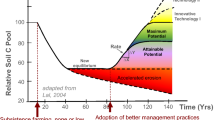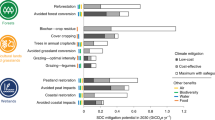Abstract
Soil and other Earth scientists who conduct research on C management found themselves, in the past decade within a swirl of efforts concerning climate mitigation, economic and business investments in carbon markets, and political aspirations. All these external pressures are issues with which soil science is largely unfamiliar. As a result, science has responded without deeply considering the landscape in which it finds itself, and some of the unanticipated challenges these issues present. Here, we suggest soil C scientists now consider and respond to these issues. The first order challenge is to transition from the concept of technical carbon sequestration potentials, made in the absence of social and policy contexts, to societally achievable sequestration estimates based on highly transdisciplinary teams of natural and social sciences and scientists. To achieve this will requires re-thinking national science funding programs, in which climate-relevant social science is under-funded. In addition, the science of soil C itself is in need of a priority shift. Presently, publications in soil C sequestration out-strip papers on soil feedbacks to climate change, and on how to adapt soil to climate change: two areas of research which may well be more societal important in the next few decades than sequestering C. Most seriously, given the urgent nature of our collective societal climate problem, our profession must not find itself a decade from now continuing the now 20-year-old narrative that soil C can potentially mitigate climate change and compensate for greenhouse gas emissions. We must consider the possibility that other options and expenditures of resources are more viable, and we must reframe our science’s objectives to expand into the many other urgent needs that confront humanity.




Similar content being viewed by others
Data availability
There is no data generated for this paper.
Notes
A cursory—and admittedly incomplete—review of papers in Biogeochemistry, Science, Nature, Soil Science Society of America Journal in the past 3 years reveals no reported conflicts of interest, by university professors, in soil carbon management related topics, a result that cannot be true given the pace of evolution of business relations the field. This may be simply due to a poor definition or articulation of what COI means, or an assumption that a submission from a university address is adequate separation of interests.
References
Amundson R (2020) The policy challenges to managing soil resources. Geoderma. https://doi.org/10.1016/j.geoderma.2020.114639
Bastin J-F, Finegold Y, Garcia C, Mollicone D, Rezende M, Routh D, Zohner CM, Crowther TW (2019) The global tree restoration potential. Science 365:76–79
Beerling DJ, Kantzas EP, Lomas MR et al (2020) Potential for large-scale CO2 removal via enhanced rock weathering with croplands. Nature 583:242–248. https://doi.org/10.1038/s41586-020-2448-9
Buck HJ, Furhman J, Morrow DR, Sanchez DL, Wang FM (2020) Adaptation and carbon removal. One Earth 3(4):425–435
Cash DW, Borck JC, Patt AG (2006) Countering the loading-dock approach to linking science and decision making: comparative analysis of El Nino/Southern Oscillation (ENSO) forecasting systems. Sci Technol Hum Values 31:465–494
Crowther TW, Todd-Brown KEO, Rowe CW, Wieder WR, Carey JC, Machmuller MB, Snoek BL, Fang S, Zhou Z, Allison SD, Blair JM, Bridgham SD, Burton AJ, Carrillo Y, Reich PB, Clark JS, Classen AT, Kijkstra FA, Eberling B, Emmett BA, Estiarte M, Frey SD, Guo J, Harte J, Jiang L, Johnson BR, Kroel-Dulay G, Larsen KS, Laudon H, Lavallee JM, Luo Y, Lupascu M, Ma LN, Marhan S, Michelsen A, Mohan J, Niu S, Pendall E, Penuelas J, Pfeifer-Meister L, Poll C, Reinsch S, Reynolds LL, Schmidt IK, Sistla S, Sokol NW, Temper PH, Teseder KK, Welker JM, Bradford MA (2016) Quantifying soil carbon losses in response to warming. Nature 540:104–108
Davidson EA, Janssens IA (2006) Temperature sensitivity of soil carbon decomposition and feedbacks to climate change. Nature 440:165–173
Dowell G, Niederdeppe J, Vanucchi J, Dogan T, Donaghy K, Jacobson R, Mahowald N, Milstein M, Zelikova TJ (2020) Rooting carbon dioxide removal research in the social sciences. Interface Focus 10(5):20190138
Droste N, May W, Clough Y, Borjesson G, Brady M, Hedlund K (2020) Soil carbon insures arable crop production against increasing adverse weather due to climate change. Environ Res Lett 15:124034
Glavovic BC, Smith TF, White I (2021) The tragedy of climate change science. Clim Dev. https://doi.org/10.1080/17565529.2021.2008855
Grundmann R (2016) Climate change as a wicked social problem. Nat Geosci 9:562–563
Handelsman J (2021) A world without soil. Yale University Press, New Haven
Hermoso V, Regos A, Morán-Ordóñez A, Duane A, Brotons L (2021) Tree planting: a double-edged sword to fight climate change in an era of megafires. Glob Change Biol 27:3001–3003
Hulme M (2020) One earth, many futures, no destination. One Earth 2(4):309–311
Jenny H (1929) Relation of temperature to the amount of nitrogen in soils. Soil Sci 27:169–188
Jordan TH, Ashley GM, Barton MD, Burges SJ, Farley KA, Freeman KH, Jeanloz R, Marshall CR, Orcutt JA, Richter FM, Royden LH, Scholz CH, Tyler M, Wilding LP (2001) Basic research opportunities in earth science. National Academy Press, Washington, D.C.
Lawrence DM, Fisher RA, Koven CD, Oleson KW, Swenson SC, Bonan G, Collier N, Ghimire B, van Kampenhout L, Kennedy D, Kluzek E, Lawrence PJ, Li F, Li H, Lombardozzi D, Riley WJ, Sacks WJ, Shi M, Vertenstein M, Wieder WR, Xu C, Ali AA, Badger AM, Bisht G, van den Broeke M, Brunke MA, Burns SP, Buzan J, Clark M, Craig A, Dahlin K, Drewniak B, Fisher JB, Flanner M, Fox AM, Gentine P, Hoffman F, KeppelAleks G, Knox R, Kumar S, Lenaerts J, Leung LR, Lipscomb WH, Lu Y, Pandey A, Pelletier JD, Perket J, Randerson JT, Ricciuto DM, Sanderson BM, Slater A, Subin ZM, Tang J, Thomas RQ, Val Martin M, Zeng X (2019) The community land model version 5: description of new features, benchmarking, and impact of forcing uncertainty. J Adv Model Earth Syst 11:4245–4287
Lessmann M, Ros GH, Young MD, de Vries W (2021) Global variation in soil carbon sequestration potential through improved cropland management. Glob Change Biol. https://doi.org/10.1111/gcb15954
Lubchenco J (1998) Entering the century of the environment: a new social contract for science. Science 279:491–497
Lundh A, Sismondo S, Lexchin J, Busuioc OA, Bero L (2012) Industry sponsorship and research outcome. Cochrane Database Syst Rev 12:MR000033. https://doi.org/10.1002/14651858.MR000033.pub2
Markusson N, Balta-Ozkan N, Chilvers J, Healey P, Reiner D, MclAren D (2020) Social science sequestered. Front Clim. https://doi.org/10.3389/fclim.2020.00002
National Academies of Sciences, Engineering, and Medicine (2019) Negative emissions technologies and reliable sequestration: a research agenda. The National Academies Press, Washington, DC. https://doi.org/10.17226/25259
Northrup DL, Basso B, Wang MQ, Morgan CLS, Benfey PN (2021) Novel technologies for emission reduction complement conservation agriculture to achieve negative emissions from row-crop production. Proc Natl Acad Sci USA 118(28):e2022666118
Oreskes N, Carlat D, Mann ME, Thacker PD, vom Saal FS (2015) Viewpoint: why disclosure matters. Environ Sci Technol 49:7527–7528
Overland I, Sovacool BK (2020) The misallocation of climate research funding. Energy Res Soc Sci 62:101349
Paustian K, Lehmann J, Ogle S, Reay D, Robertson GP, Smith P (2016) Climate-smart soils. Nature 532:49–57
Raynor S (2010) How to eat an elephant: a bottom-up approach to climate policy. Clim Policy 10:615–621
Renwick LLR, Deen W, Silva L, Gilbert ME, Maxwell T, Bowles TM, Gaudin ACM (2021) Long-term crop rotation diversification enhances maize drought resistance through soil organic matter. Environ Res Lett 16:084067
Richter DD, Bacon AR, Mobley MA, Richardson CJ, West L, Wills S, Andrews SS, Billings S, Cambardella CA, Cavallaro N, De Meester JE, Franzluebbers AJ, Grandy AS, Grunwald S, Gruver J, Hartshorn AS, Janzen H, Kramer MG, Ladha JK, Lajtha K, Liles GC, Markewitz D, Megonigal PJ, Mermut AR, Rasmussen C, Robinson DA, Smith P, Stiles C, Tate RL III, Thompson A, Tugel AJ, Es HV, Yaalon D, Zobeck TM (2011) Human–soil relations are changing rapidly: proposals from SSSA’s Cross-Divisional Soil Change Working Group. Soil Sci Soc Am J 75:2079–2084
Rogga S (2021) Transcending the loading dock paradigm—rethinking science-practice transfer and implementation in sustainable land management. In: Weith T, Barkmann T, Gaasch N, Rogga S, Strauß C, Zscheischler J (eds) Sustainable land management in a European context. Human-environment interactions, vol 8. Springer, Cham. https://doi.org/10.1007/978-3-030-50841-8_13
Seehusen DA, Koren KG (2013) Impact of industry sponsorship on research outcomes. Am Fam Physician 88:746
Steinman MA, Shlipak MG, McPhee SJ (2001) Of principles and pens: attitudes and practices toward pharmaceutical industry promotions. Am J Med 110:551–557
Suldovsky B (2017) The information deficit model and climate change communication. Clim Sci. https://doi.org/10.1093/acrefore/9780190228620.013.301
Sweet SK, Schuldt JP, Lehmann J, Bossio DA, Woolf D (2021) Perceptions of naturalness predict US public support for soil carbon storage as a climate solution. Clim Change 166(1):1–15
Tollefson J (2015) Earth science wrestles with conflict-of-interest policies. Nature 522:403–404
Watts DJ (2017) Should social science be more solution-oriented? Nat Hum Behav 1:0015
Weise L, Wollenberg E, Alcantara-Shivapatham V, Richards M, Shelton S, Honle SE, Heidecke C, Madari BE, Chenu C (2021) Countries’ commitments to soil organic carbon in nationally determined contributions. Clim Policy 21(8):1005–1019
Wolske KS, Raimi KT, Campbell-Arvai V, Hart PS (2019) Public support for carbon dioxide removal strategies: the role of tampering with nature perceptions. Clim Change 152(3):345–361
Acknowledgements
This paper, and the special issue of which it is a part, resulted from the participation and enlivening discussion by many in the 2021 AGU symposium “Challenges and Opportunities of Managing Soil Carbon as a Natural Climate Solution.”
Funding
Amundson received support from the University of California Agricultural Experiment Station and the Betty and Isaac Barshad Chair in Soil Science.
Author information
Authors and Affiliations
Corresponding author
Ethics declarations
Conflict of interest
All authors declare they have no conflicts of interest.
Additional information
Responsible Editor: Jonathan Sanderman.
Publisher's Note
Springer Nature remains neutral with regard to jurisdictional claims in published maps and institutional affiliations.
Rights and permissions
About this article
Cite this article
Amundson, R., Buck, H. & Lajtha, K. Soil science in the time of climate mitigation. Biogeochemistry 161, 47–58 (2022). https://doi.org/10.1007/s10533-022-00952-6
Received:
Accepted:
Published:
Issue Date:
DOI: https://doi.org/10.1007/s10533-022-00952-6




